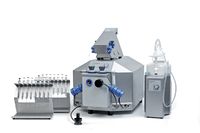Difference between revisions of "High-resolution respirometry"
| Line 1: | Line 1: | ||
{{MitoPedia | {{MitoPedia | ||
|abbr= | |abbr=HRFR | ||
|description=[[Image:O2k-Fluorometer. | |description=[[Image:O2k-Fluorometer.jpg|200px|left|O2k-FluoRespirometer]] | ||
Mitochondrial function and dysfunction have gained an increasing interest over the past years, reflecting growing awareness of the fact that mitochondria play a pivotal role in human health and disease. The most advanced way to analyze mitochondrial function is by means of | '''High-Resolution FluoRespirometry, HRFR''' is an extension of High-Resolution Respirometry (HRR) using the [[O2k-FluoRespirometer]]. Mitochondrial function and dysfunction have gained an increasing interest over the past years, reflecting growing awareness of the fact that mitochondria play a pivotal role in human health and disease. The most advanced way to analyze mitochondrial function is by means of High-Resolution FluoRespirometry with the [[Oroboros O2k]]. Substrate-uncoupler-inhibitor titration (SUIT) protocols allow the diagnosis of numerous mitochondrial pathway and coupling defects in a single respirometric assay. Technologically, HRFR is based on the Oroboros O2k, combining optimized chamber design, application of oxygen-tight materials, electrochemical sensors, Peltier-temperature control, [[Smart Fluo-Sensor]]s, and specially developed software features (DatLab) to obtain the unique sensitive and quantitative resolution of oxygen concentration and oxygen flux, with both, a closed-chamber or open-chamber mode of operation ([[TIP2k-Module|TIP2k]]) in combination with fluorometric signals using specific fluorophores. Standardized calibration of the polarographic oxygen sensor (static sensor calibration), calibration of the sensor response time (dynamic sensor calibration), and evaluation of instrumental background oxygen flux (systemic flux compensation) provide the experimental basis for high accuracy of quantitative results and quality control in HRFR. | ||
|info=[[ | |info=[[Oroboros O2k]] | ||
}} | }} | ||
[[File:O2k-Core to FluoRespirometer.jpg|right|400px |O2k-Core to FluoRespirometer]] | |||
{{MitoPedia methods | {{MitoPedia methods | ||
|mitopedia method=Respirometry | |mitopedia method=Respirometry, Fluorometry, Spectrophotometry | ||
}} | }} | ||
{{MitoPedia O2k and high-resolution respirometry | {{MitoPedia O2k and high-resolution respirometry | ||
|mitopedia O2k and high-resolution respirometry=O2k hardware | |mitopedia O2k and high-resolution respirometry=O2k hardware | ||
}} | }} | ||
::::* <big>'''Power-O2k''':</big> Several O2k units are operated simultaneously ('''P'''1, '''P'''2, ..) to combine high-resolution respirometry with [[Power-O2k |high-output]]. | |||
::::* '''<big>[[Oroboros O2k |O2k-Concept]]</big>''' | |||
== MitoPedia: O2k and high-resolution respirometry == | |||
::::» [[MitoPedia: O2k hardware]] | |||
::::» [[MitoPedia: DatLab]] | |||
::::» [[MitoPedia: SUIT]] | |||
== Links == | |||
::::'''»''' [[MitoPedia: Respiratory states]] [[Image:P.jpg|link=OXPHOS capacity|OXPHOS]] [[Image:R.jpg|link=ROUTINE respiration|ROUTINE]] [[Image:E.jpg|link=ETS capacity|ETS]] [[Image:L.jpg|link=LEAK respiration|LEAK]] - [[Image:ROX.jpg|link=Residual oxygen consumption|ROX]] | |||
::::» [[Respirometry]] | |||
::::» [[MitoPedia: Respirometry]] | |||
::::» [http://en.wikipedia.org/wiki/Respirometry Wikipedia: Respirometry] | |||
::::» [[O2k Applications]] | |||
<br /> | <br /> | ||
[[File:Expand.png|right|45px |Click to expand or collaps]] | [[File:Expand.png|right|45px |Click to expand or collaps]] | ||
| Line 41: | Line 58: | ||
::::» [[Respirometry]]; » [[MitoPedia: Respirometry]] | ::::» [[Respirometry]]; » [[MitoPedia: Respirometry]] | ||
::::» [[SUIT| Substrate-uncoupler-inhibitor titration (SUIT) protocols]]; » [[MitoPedia: SUIT]] | ::::» [[SUIT| Substrate-uncoupler-inhibitor titration (SUIT) protocols]]; » [[MitoPedia: SUIT]] | ||
</div> | |||
</div> | |||
<br /> | |||
[[Image:O2k-Publications.jpg|left|116px|link=O2k-Publications: Topics|O2k-Publications in the MiPMap]] | |||
<br /> | |||
[[File:Expand.png|right|45px |Click to expand or collaps]] | |||
<div class="toccolours mw-collapsible mw-collapsed"> | |||
::: <span style="font-size:105%; color:##424242">'''» References'''</span> | |||
<div class="mw-collapsible-content"> | |||
::: '''O2k-Publications''' | |||
::::* [[O2k-Publications |O2k-Publications: Chronological]] | |||
::::* [[O2k-Publications: Topics]] | |||
::: '''Selected references''' | |||
::::* [[Gnaiger 1995 J Bioenerg Biomembr]] | |||
::::* [[Gnaiger 2001 Respir Physiol]] | |||
::::* [[Gnaiger 2008 POS]] | |||
::::* [[Gnaiger 2014 MitoPathways]] | |||
</div> | </div> | ||
</div> | </div> | ||
<br /> | <br /> | ||
Revision as of 10:54, 22 August 2017
Description
High-Resolution FluoRespirometry, HRFR is an extension of High-Resolution Respirometry (HRR) using the O2k-FluoRespirometer. Mitochondrial function and dysfunction have gained an increasing interest over the past years, reflecting growing awareness of the fact that mitochondria play a pivotal role in human health and disease. The most advanced way to analyze mitochondrial function is by means of High-Resolution FluoRespirometry with the Oroboros O2k. Substrate-uncoupler-inhibitor titration (SUIT) protocols allow the diagnosis of numerous mitochondrial pathway and coupling defects in a single respirometric assay. Technologically, HRFR is based on the Oroboros O2k, combining optimized chamber design, application of oxygen-tight materials, electrochemical sensors, Peltier-temperature control, Smart Fluo-Sensors, and specially developed software features (DatLab) to obtain the unique sensitive and quantitative resolution of oxygen concentration and oxygen flux, with both, a closed-chamber or open-chamber mode of operation (TIP2k) in combination with fluorometric signals using specific fluorophores. Standardized calibration of the polarographic oxygen sensor (static sensor calibration), calibration of the sensor response time (dynamic sensor calibration), and evaluation of instrumental background oxygen flux (systemic flux compensation) provide the experimental basis for high accuracy of quantitative results and quality control in HRFR.
Abbreviation: HRFR
Reference: Oroboros O2k
MitoPedia methods: Respirometry, Fluorometry, Spectrophotometry
MitoPedia O2k and high-resolution respirometry:
O2k hardware
- Power-O2k: Several O2k units are operated simultaneously (P1, P2, ..) to combine high-resolution respirometry with high-output.
MitoPedia: O2k and high-resolution respirometry
Links
- » Keywords
- Instrument
- » DatLab; » MitoPedia: DatLab
- » Instrumental background oxygen flux »» MiPNet14.06 Instrumental O2 background
- » Oroboros O2k-Core (O2k-Series D - G)
- » O2k-FluoRespirometer
- » O2k-MultiSensor
- » Oroboros O2k; » MitoPedia: O2k hardware
- » Power-O2k
- » Static sensor calibration
- » TIP2k
- Instrument
- Concept
- » Concentration
- » Coupling control state
- » High-Resolution FluoRespirometry
- » Mitochondrial preparations
- » Oxidative phosphorylation
- » Oxygen, dioxygen, O2
- » Oxygen flux
- » Pathway control state
- » Respiration
- » Respirometry; » MitoPedia: Respirometry
- » Substrate-uncoupler-inhibitor titration (SUIT) protocols; » MitoPedia: SUIT
- Concept
- » References
- O2k-Publications




